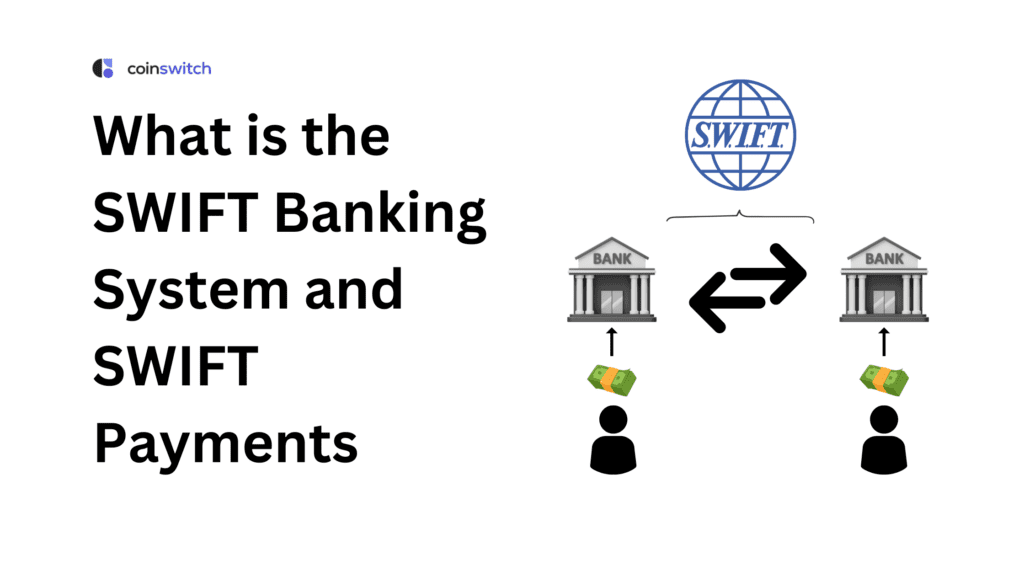Transferring money across borders is rather simple these days. With a few clicks on your bank’s website, you can send money to an individual or entity located in any country worldwide. Yet what type of infrastructure underpins these transactions, and how precisely does it operate? The SWIFT banking system plays a significant role in facilitating the global money transfer ecosystem. Thus, the SWIFT banking system is essential to the global financial system.
What is the SWIFT banking system?
The Society for Worldwide Interbank Financial Telecommunications (SWIFT) system handles most money exchanges between countries. Its main goal is to make it easier and safer for banks to communicate with each other across borders. Even though SWIFT is used to send messages that start and confirm financial deals, it is not a payment system itself.
By standardizing communication methods, the SWIFT banking system ensures that banks can safely do business across borders, lowering the risks associated with international business. Moreover, the SWIFT message network lets financial institutions share and receive information, like directions for money transfers, quickly, correctly, and safely.
Inside a SWIFT transaction
SWIFT is a standard code method that financial institutions use to send information and orders safely. Even though SWIFT is an important part of the global banking system, it is not a bank. SWIFT doesn’t hold or move assets; it helps partner institutions communicate safely and quickly.
A bank identifier code, or BIC, is a unique code SWIFT gives to each banking institution. It can have eight or eleven characters. The BIC may also refer to itself as a SWIFT code, ID, or ISO 9362 Code. Further, to understand the code assignment, consider Milan-based UniCredit Banca. UNCRITMM is its eight-character SWIFT code.
- The institute code (UNCR for UniCredit Banca) is the first four characters.
- Next are the two characters that represent the country code. For example, IT stands for Italy.
- The next two characters are the city code and location (MM for Milan).
- The last three letters are optional, but some companies use them to give codes to different branches.
How to send money with SWIFT?
Here are the steps you need to take to make an international payment via SWIFT bank transfer:
Collect the Information You Need
- Recipient’s Information: Bank’s name, address, country, routing code, complete legal name, present address, and account number.
- SWIFT Code: The recipient’s bank’s unique code
- Your ID: A government-issued document
- Reason for Transfer: Clearly state the purpose for sending money
- Extra Documentation: Any additional information your bank requires
Start the Transfer
- Go to the Bank: You can go to a bank branch or use their internet banking service.
- Request for a SWIFT Transfer: To pay, choose an international wire transfer or a SWIFT bank transfer system.
- Fill the Transfer Form: Give the information you’ve gathered, such as the recipient’s name, address, SWIFT code, and the reason for the payment.
- Examine the Transfer Information: Check all the information you entered to make sure it’s correct and there are no mistakes.
- Verify the Transaction: Verify your request to authorize the transfer, and if asked, provide extra authentication (like an OTP).
Check the Limits and Fees
Know all the fees and limits associated with sending money abroad. You should also provide information about where the money is going, the currency, and the other items listed above.
Finalize the Transaction
Keep track of the transaction and have the funds sent via your bank using the SWIFT network. Give the sender your bank’s SWIFT number. This may differ based on whether you collect payments in USD or other foreign currency.
Vital Considerations
- Most SWIFT bank transfers take between two and five working days.
- Safety is very important. Carefully check all of the recipient’s information.
- Consider using different ways to send money, such as money transfer services, which might be cheaper and faster, particularly for smaller amounts.
The world before SWIFT
Telex was the only option for confirming international money transfers before the launch of the SWIFT bank transfer system. Telex was compromised due to slow speeds, security issues, and the use of a free message format. Put otherwise, Telex lacked a standardized set of codes, similar to SWIFT, for identifying banks and characterizing transactions.
People using Telex had to write down every exchange in words that the person receiving the message had to understand and carry out. This caused many mistakes and made things take longer to handle.
In 1973, 239 banks from 15 countries set up the SWIFT system. This was done to get around these shortcomings. As the Worldwide Interbank Financial Telecommunication’s main office in Belgium, the global network would send and receive financial messages quickly and safely. However, SWIFT launched its messaging services in 1977.
Read More: Top 5 Small Finance Bank Shares in India 2025
Why is SWIFT dominant?
The SWIFT banking system now has over 11,000 institutional members from across 200 countries and territories. Some other message services are Fedwire, Ripple, and the Clearing House Interbank Payments System (CHIPS), but SWIFT is the market leader. Further, the platform’s security and constant addition of message codes for financial transactions may explain its success.
The US does not participate in the International Bank Account Number (IBAN), while other nations use it to identify international bank accounts beyond national boundaries. When it started, SWIFT was mostly used to send easy payment guidance. These days, it sends many messages, such as security, finance, trade, and system activities.
According to Swift’s most recent report, 44 percent of SWIFT traffic is still related to payments, while 51 percent is related to securities messages. Further, trade, treasury, and system activities get the rest of the traffic. The daily number of SWIFT transfers hit almost 50 million messages by the end of 2022, though growth slowed.
Read More: What Do Investment Bankers Really Do?
Who owns the SWIFT system?
The shareholders, which include specific member financial institutions, represent a variety of businesses around the globe and run SWIFT as a cooperative. The central banks of the G-10 countries are in charge of SWIFT. This group of countries includes the United States, Canada, France, Germany, Italy, Japan, the Netherlands, Sweden, and Switzerland. Moreover, one of the main overseers is Belgium. Other members include the US Federal Reserve.
All countries depend on the SWIFT bank transfer system to communicate quickly, easily, and safely, so they have a reason to stay in good standing with the group. The Group of Ten (G10) countries’ central banks monitor SWIFT. It is a neutral organization that works for the betterment of all its members.
SWIFT Services
There are a lot of services that companies and people can use to make SWIFT transfers smooth and accurate.
- Applications
SWIFT offers real-time instruction matching for forex and treasury transactions. Besides, it provides banking market infrastructure for payment instructions between banks. Additionally, it offers securities market infrastructure for clearing and settlement instructions for payments, securities, forex, and derivatives.
- Business Intelligence
The SWIFT banking system offers dashboards and reporting tools to give customers a real-time view of messages, activity, trade flow, and reporting. Besides, filtering is possible based on area, country, message type, and additional parameters.
- Compliance Services
SWIFT offers reports and methods for Know Your Customer (KYC), sanctions, and anti-money laundering (AML), all of which aim to help businesses avoid financial crime.
- Solutions for Software, Connectivity, and Messaging
Providing a safe, dependable, and expandable network for seamless message transfer is the SWIFT operation’s foundation. Customers of SWIFT can send and receive financial messages using its different messaging hubs, software, and network links.
How does SWIFT make money?
SWIFT members are organized into groups based on how many shares they own. All members pay an initial fee and yearly fees that are different for each user class.
Additionally, SWIFT charges customers for every message according to its length and kind. These fees change based on the bank’s usage. There are different levels of fees for banks that send out various numbers of messages.
SWIFT has also added the services mentioned above. These services provide SWIFT with other revenue sources, including reference data, business analytics, and compliance services.
Challenges for SWIFT
Most SWIFT clients handle enormous transaction volumes, making manual instruction input impractical. Automating the creation, handling, and sending of SWIFT messages is becoming increasingly important. But there is a price for this, and higher operating expenses.
However, there is a cost to SWIFT’s efficient software for automating tasks. The SWIFT banking system would need to address these issues for most clients. Automated solutions in this area help SWIFT make more money and keep clients interested over time.
SWIFT and economic sanctions
SWIFT often restricts certain countries’ access to the global banking system. For instance, the European Union (EU) issued sanctions in 2012 that cut off sanctioned Iranian banks from the SWIFT network because of Iran’s controversial nuclear energy program.
In another instance, the EU stopped SWIFT from working with certain Russian and Belarusian companies and their businesses in 2022. These measures were meant to prevent Russia from being aggressive towards Ukraine and to stop Belarus from helping Russia do this.
As a global financial messaging company, the SWIFT banking system has to follow EU rules since it is based in Belgium.
The Bottom Line
SWIFT is easily the most popular way to send and receive processing messages worldwide. It has recently moved into new areas, like providing reporting systems and data for business intelligence, which shows that it wants to keep coming up with new ideas. However, the SWIFT banking system looks set to maintain its market dominance in the short to medium term.
FAQs
1. How does the SWIFT banking system work?
The SWIFT banking system sends financial messages safely and quickly between banks worldwide. It permits standard communication for international payments and ensures that transfers are secure, efficient, and accurate.
2. What does SWIFT mean in banking?
Financial institutions employ SWIFT, a global messaging network, to send safe and correct guidance for money transfers.
3. Who controls the SWIFT banking system?
The board that governs the SWIFT banking system includes financial institutions from key global economies, and its member banks supervise it.
4. How does SWIFT actually work?
SWIFT sends standard financial messages safely between banks, allowing them to transfer money between countries.








